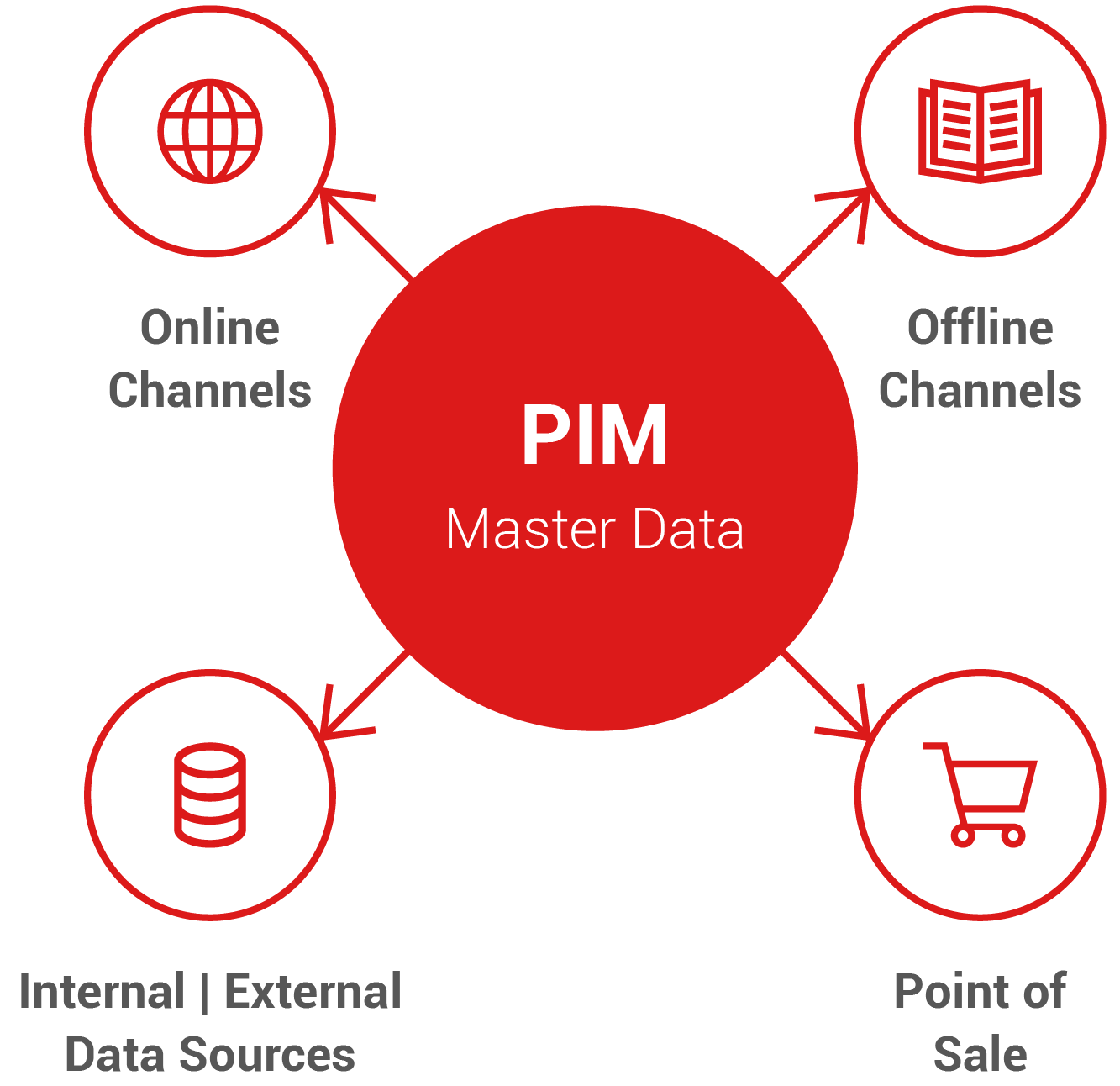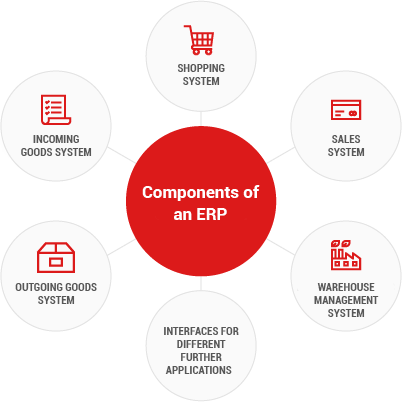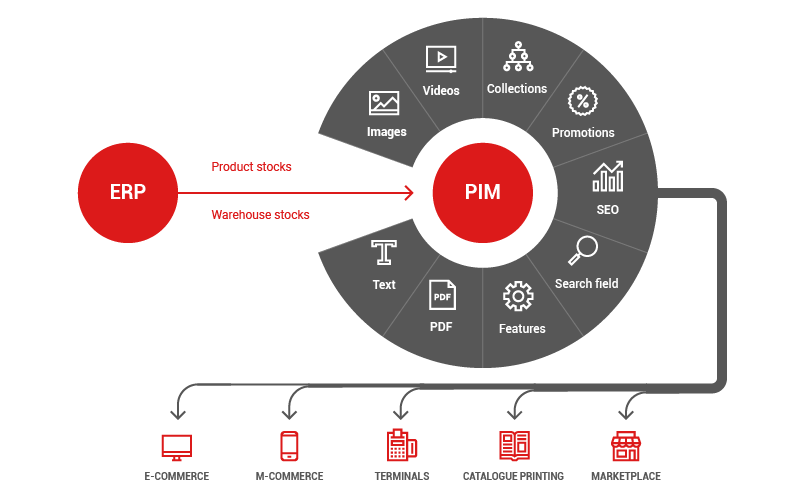
Table of Contents
Both systems are very important for a modern manufacturer, wholesaler or retailer. To understand what is the difference and how the both systems can extend each other read this article.
What is PIM and what is it for?
 Product Information Management (PIM) is a business software that allows managing the product information of a producer, wholesaler or online retailer centrally, as in a repository. PIM software ensures the collection, processing and maintenance of product data as well as providing partners and distributors with this information through various output channels and media.
Product Information Management (PIM) is a business software that allows managing the product information of a producer, wholesaler or online retailer centrally, as in a repository. PIM software ensures the collection, processing and maintenance of product data as well as providing partners and distributors with this information through various output channels and media.
The most important features of a PIM system are:
- Import and collection of product data from different sources
- Data processing with the primary goal of increasing data quality
- Export of information via various channels or their publication
What is ERP and what is it for?
 ERP software (Enterprise Resource Planning) is used for efficient planning and control of product-related processes in a company. Unlike a MMS (Merchandise Management System), an ERP system controls not only product-related business processes, but also all resources that exist within a company so that different areas and departments could work together efficiently. An ERP software offers much more than a MMS and it’s a central point for all important process-oriented data dealing with the functioning of a company.
ERP software (Enterprise Resource Planning) is used for efficient planning and control of product-related processes in a company. Unlike a MMS (Merchandise Management System), an ERP system controls not only product-related business processes, but also all resources that exist within a company so that different areas and departments could work together efficiently. An ERP software offers much more than a MMS and it’s a central point for all important process-oriented data dealing with the functioning of a company.
The most important features of an ERP system are:
- materials management, i.e. control of purchasing and warehousing
- order processing, i.e. everything that relates to the sales processes, including the delivery of the goods to the customers
- production control and planning that means the optimal usage of manufacturing staff and necessary machines
How do they work together?
When talking about integration of ERP and PIM, the most frequently asked question is why do I need a PIM when I already use an ERP?
An ERP focuses on organizing and optimizing all sales-related business processes such as purchasing, manufacturing, warehouse management, order processing and logistics, but not on the product description itself. The information contained in an ERP is neither sufficient in scope nor in quality to meet the requirements for marketing of the products.
The quality of product data, which are collected in an ERP can be simply not good enough - in some systems there are e.g. insufficient technical possibilities, e.g. to store product features, in other systems there is a lack in organization of cooperation of all those, who are involved in the preparation of qualitative product information. It is possible that not all specialists (such as marketing, SEO specialists, technical translators, photographers, etc.) responsible for preparing necessary data have or should have access to the ERP.
PIM systems allow to receive the information about products from the ERP system and to enrich it for marketing and sales purposes. This will be possible the integration of both systems via connector. So, an ERP system ensures quantitative (assortment, stocks) and a PIM system qualitative information. This enriched product information can be then published in an online store or in a product catalogue and through many other channels.
A PIM would allow you to deliver product photos of the best possible or necessary quality. In an ERP, the quality of the images may be poor because image editing e.g. is not possible at all. A PIM system can never replace an ERP but is an essential extension if you want to provide more qualitative information about your products than just the product name and a couple of words to describe it to the customers. A PIM also creates more space and enables you to plan better and carry out the product launches faster.

It makes no sense to fill the products that are not ready yet for sale in an ERP system, but they can be processed, translated and be available at a corresponding qualitative level in a PIM system. It makes more sense to start the product lifecycle in a PIM. All new product launches can first be recorded in the PIM till a product is ready for sale and thus should be recorded in your ERP system.
Conclusion
There are different PIM and ERP solutions on the market. And there are differences in the way they can be interconnected. Some PIM systems allow data exchange only from ERP to PIM. The others allow data exchange in both directions. Integration can take place by exchanging files. A better way to ensure error-free data exchange would be to use an API connector of one of the systems. So you can implement any integration scenarios, no matter what special features you have.
While an ERP concentrates on manages business processes with products, the product itself is in the focus of a PIM system, because the PIM doesn’t work with products, but on products.
The implementation of both systems - tERP and PIM systems - brings many benefits, provided that they are interconnected for automatic data exchange.
Smooth integration of your PIM system with all necessary distribution channels, including your website, partner portal or online store, will ensure consistency and transparency of your entire product-related communication with your customers. Product information management system ensures that products are ordered, and moreover the right products, and an ERP ensures that orders are processed quickly and easily.
The two systems complement each other because, despite some similarities, they serve different goals. The implementation of a PIM system in addition to an ERP helps you to save time and money while delivering better quality product information to your partners and distributors.

